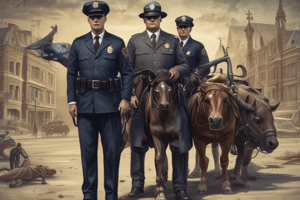Podcast
Questions and Answers
Which of the following is NOT a characteristic of professionalism as described in the text?
Which of the following is NOT a characteristic of professionalism as described in the text?
- Integrity
- Honesty
- Self-promotion (correct)
- Courage
What is the most valuable non-verbal tool an officer possesses?
What is the most valuable non-verbal tool an officer possesses?
- A commanding voice
- Command Presence (correct)
- A professional uniform
- A strong handshake
What is one way to improve your self-confidence, credibility, and command presence?
What is one way to improve your self-confidence, credibility, and command presence?
- Surrounding yourself with positive people
- Working out regularly
- Reading self-help books
- Training, education, and experience (correct)
What is the best way to respond when a person's request seems unrealistic?
What is the best way to respond when a person's request seems unrealistic?
Which of the following phrases should be avoided in professional communication, according to the text?
Which of the following phrases should be avoided in professional communication, according to the text?
What does the acronym LEED stand for, as mentioned in the text?
What does the acronym LEED stand for, as mentioned in the text?
What is the BEST way to improve your professional demeanor in your career?
What is the BEST way to improve your professional demeanor in your career?
What does the text suggest is the most important aspect of projecting a positive self-image?
What does the text suggest is the most important aspect of projecting a positive self-image?
Which of the following is NOT a factor that can negatively impact an officer's communication with a community?
Which of the following is NOT a factor that can negatively impact an officer's communication with a community?
What could potentially destroy the goodwill built between an officer and a community?
What could potentially destroy the goodwill built between an officer and a community?
What is the MAIN reason why it is essential for an officer to understand the belief systems of different cultures?
What is the MAIN reason why it is essential for an officer to understand the belief systems of different cultures?
Why is it important for an officer to be aware of non-verbal cues when interacting with diverse communities?
Why is it important for an officer to be aware of non-verbal cues when interacting with diverse communities?
Which of the following is NOT a step an officer can take to improve communication with diverse communities?
Which of the following is NOT a step an officer can take to improve communication with diverse communities?
What is the key takeaway from the text regarding building rapport with diverse communities?
What is the key takeaway from the text regarding building rapport with diverse communities?
What is the meaning of the term "intercultural communication" as used in the context of this text?
What is the meaning of the term "intercultural communication" as used in the context of this text?
Which statement BEST reflects the importance of an officer's ability to communicate effectively with diverse communities?
Which statement BEST reflects the importance of an officer's ability to communicate effectively with diverse communities?
How would officers demonstrate a sincere willingness to learn about the community they serve?
How would officers demonstrate a sincere willingness to learn about the community they serve?
What is the primary reason why it is important for law enforcement agencies to partner with the community in crime prevention?
What is the primary reason why it is important for law enforcement agencies to partner with the community in crime prevention?
When a person shifts their weight, crosses their arms, or exhibits other sudden physical changes, what aspect of nonverbal communication is being demonstrated?
When a person shifts their weight, crosses their arms, or exhibits other sudden physical changes, what aspect of nonverbal communication is being demonstrated?
If someone appears nervous and starts rocking back and forth, twitching their eyes, or shaking their legs, what might this suggest?
If someone appears nervous and starts rocking back and forth, twitching their eyes, or shaking their legs, what might this suggest?
Which of the following is NOT a universal facial expression across most cultures?
Which of the following is NOT a universal facial expression across most cultures?
How can touch be used as a form of nonverbal communication in a professional setting?
How can touch be used as a form of nonverbal communication in a professional setting?
What is the importance of considering the person’s facial expression when interpreting their verbal message?
What is the importance of considering the person’s facial expression when interpreting their verbal message?
When interviewing someone, what specific nonverbal cues can indicate interest?
When interviewing someone, what specific nonverbal cues can indicate interest?
What is the primary message conveyed by turning away from someone during a conversation?
What is the primary message conveyed by turning away from someone during a conversation?
Which aspect of nonverbal communication focuses on how we sit, walk, and stand?
Which aspect of nonverbal communication focuses on how we sit, walk, and stand?
Why is it important to stay objective regarding a person's dress when assessing their nonverbal cues?
Why is it important to stay objective regarding a person's dress when assessing their nonverbal cues?
What is the purpose of questioning if someone’s nonverbal communication matches their verbal message?
What is the purpose of questioning if someone’s nonverbal communication matches their verbal message?
What is the primary purpose of self-talk for law enforcement professionals?
What is the primary purpose of self-talk for law enforcement professionals?
Which technique can aid in maintaining professionalism during emotionally charged situations?
Which technique can aid in maintaining professionalism during emotionally charged situations?
How should an officer respond to their perception of a situation while communicating?
How should an officer respond to their perception of a situation while communicating?
What role does empathy play in communication for law enforcement officers?
What role does empathy play in communication for law enforcement officers?
What is a negative consequence of allowing anger to escalate during a situation?
What is a negative consequence of allowing anger to escalate during a situation?
Why is it important for an officer to control their emotions during interactions?
Why is it important for an officer to control their emotions during interactions?
What can enhance an officer's ability to assess a situation objectively?
What can enhance an officer's ability to assess a situation objectively?
Which of the following could be considered an act of cultural responsiveness?
Which of the following could be considered an act of cultural responsiveness?
Why is it important to learn about the languages spoken in your community?
Why is it important to learn about the languages spoken in your community?
Which of the following is NOT a key aspect of being culturally responsive?
Which of the following is NOT a key aspect of being culturally responsive?
According to the provided text, how can establishing rapport before conducting business improve communication?
According to the provided text, how can establishing rapport before conducting business improve communication?
Based on the provided text, what is the primary benefit of being culturally responsive in law enforcement?
Based on the provided text, what is the primary benefit of being culturally responsive in law enforcement?
Which aspect of being culturally responsive is emphasized by the advice to 'ask questions in a respectful manner'?
Which aspect of being culturally responsive is emphasized by the advice to 'ask questions in a respectful manner'?
The text states that 'culture is an important part of everyone’s lives and identities.' What impact can this have on community members’ feelings?
The text states that 'culture is an important part of everyone’s lives and identities.' What impact can this have on community members’ feelings?
Which of the following scenarios demonstrates the principle of 'taking the time to talk to your community members and learn their perspectives'?
Which of the following scenarios demonstrates the principle of 'taking the time to talk to your community members and learn their perspectives'?
What is the main idea conveyed in the statement, 'Everyone sees the world in a different way because each person’s experiences are unique.'?
What is the main idea conveyed in the statement, 'Everyone sees the world in a different way because each person’s experiences are unique.'?
Based on the provided text, what is the core reason for improving interpersonal communication through cultural responsiveness?
Based on the provided text, what is the core reason for improving interpersonal communication through cultural responsiveness?
Flashcards
Practicing Courtesy
Practicing Courtesy
Using polite language and showing respect for others, even when challenging situations arise.
Maintaining a Calm Presence
Maintaining a Calm Presence
Maintaining a calm demeanor, even in stressful situations. This involves controlling your emotions and reacting appropriately.
Honesty
Honesty
Being honest and truthful, even when it's inconvenient or difficult.
Recognizing and Admitting Mistakes
Recognizing and Admitting Mistakes
Signup and view all the flashcards
Respect
Respect
Signup and view all the flashcards
Professional Attitude
Professional Attitude
Signup and view all the flashcards
Professionalism
Professionalism
Signup and view all the flashcards
LEED Framework
LEED Framework
Signup and view all the flashcards
Negative Public Perception of Law Enforcement
Negative Public Perception of Law Enforcement
Signup and view all the flashcards
Importance of Officer's Demeanor
Importance of Officer's Demeanor
Signup and view all the flashcards
Impact of Unprofessional Behavior
Impact of Unprofessional Behavior
Signup and view all the flashcards
Intercultural Communication
Intercultural Communication
Signup and view all the flashcards
Culture
Culture
Signup and view all the flashcards
Communication Barriers
Communication Barriers
Signup and view all the flashcards
Nonverbal Communication
Nonverbal Communication
Signup and view all the flashcards
Building Rapport and Trust
Building Rapport and Trust
Signup and view all the flashcards
Positive Public Perception
Positive Public Perception
Signup and view all the flashcards
Community Policing
Community Policing
Signup and view all the flashcards
Vocal Cues
Vocal Cues
Signup and view all the flashcards
Appearance and Dress
Appearance and Dress
Signup and view all the flashcards
Posture
Posture
Signup and view all the flashcards
Body Language
Body Language
Signup and view all the flashcards
Body Movement
Body Movement
Signup and view all the flashcards
Facial Expressions
Facial Expressions
Signup and view all the flashcards
Touch as Nonverbal Communication
Touch as Nonverbal Communication
Signup and view all the flashcards
Physical Indicators of Stress
Physical Indicators of Stress
Signup and view all the flashcards
Matching Verbal and Nonverbal Communication
Matching Verbal and Nonverbal Communication
Signup and view all the flashcards
Contrasting Verbal and Nonverbal Communication
Contrasting Verbal and Nonverbal Communication
Signup and view all the flashcards
Self-talk for Law Enforcement
Self-talk for Law Enforcement
Signup and view all the flashcards
Self-awareness
Self-awareness
Signup and view all the flashcards
Empathy in Communication
Empathy in Communication
Signup and view all the flashcards
Remaining Objective
Remaining Objective
Signup and view all the flashcards
Controlling Emotions
Controlling Emotions
Signup and view all the flashcards
Awareness of Cultural Biases
Awareness of Cultural Biases
Signup and view all the flashcards
Calming Presence
Calming Presence
Signup and view all the flashcards
Miscommunication and Division
Miscommunication and Division
Signup and view all the flashcards
Establishing Rapport
Establishing Rapport
Signup and view all the flashcards
Cultural Responsiveness
Cultural Responsiveness
Signup and view all the flashcards
Learning about Your Community
Learning about Your Community
Signup and view all the flashcards
Demonstrating Respect for Cultures
Demonstrating Respect for Cultures
Signup and view all the flashcards
Being Open to Learning and Fixing Mistakes
Being Open to Learning and Fixing Mistakes
Signup and view all the flashcards
Asking Questions Respectfully
Asking Questions Respectfully
Signup and view all the flashcards
Different Experiences and Perspectives
Different Experiences and Perspectives
Signup and view all the flashcards
Talking to Community Members
Talking to Community Members
Signup and view all the flashcards
Study Notes
Unit 1: Fundamentals of Communication - Lesson 1: Communication Basics
- Lesson Goal: To communicate effectively using empathy, courtesy, and professionalism when serving the community.
- Think About This: A resident approaches the officer complaining about an increase in burglaries in their neighborhood and is raising their voice. How can the officer de-escalate this situation?
- Communication Skills: Law enforcement officers need strong interpersonal skills to respond appropriately and potentially avoid triggering or escalating crisis situations.
- Cultural Awareness: Officers must adapt their communication style to fit the diverse backgrounds, cultures, religious beliefs, and ethnicities of the people they interact with.
- Miscommunication: Unclear expression, communication barriers, or a failure to understand the other person's needs can lead to miscommunication and safety issues.
- Communication Methods: Includes spoken/written language, gestures, facial expressions, and body movements. Effective communication requires the speaker to send a message the listener understands, and the listener to respond to show understanding. The diagram in the text illustrates the process of effective communication.
Unit 1: Fundamentals of Communication - Lesson 2: Verbal and Non-verbal Communication
- Lesson Goal: To interpret verbal and nonverbal communication, considering the context of the incident.
- Think About This: An officer responds to a domestic disturbance call where the tenant says everything is fine, but appears nervous and is sweating. How can the officer interpret the situation based on nonverbal cues?
- Verbal Cues: Tone, volume, pitch of voice are crucial. Matching these aspects with the words used is critical to understanding the situation.
- Nonverbal Cues: Body language, facial expressions, gestures, personal space, eye contact, posture, and any other non-verbal behaviors should be attentively observed by the officer. Nonverbal cues and verbal cues should be analyzed alongside each other.
- Context is important Nonverbal cues should be interpreted based on all the surrounding details. These include physical signs of distress, environmental factors, and other situational information.
Unit 1: Fundamentals of Communication - Lesson 3: Conflict Resolution and De-escalation
- Lesson Goal: To understand communication barriers, and learn how to use conflict resolution and de-escalation skills to resolve incidents with equity and dignity.
- Think About This: An officer responds to a conflict between a homeowner and his plumber. The plumber is upset due to nonpayment, and the homeowner is refusing to pay due to perceived poor service. How can the officer de-escalate the conflict?
- Challenges to Effective Communication: Common barriers include failing to listen, using dialect, inappropriate language choices, tone, phrasing, stereotypes, non-verbal mismatches, and bias.
- Conflict Resolution Strategies: The officer must create a safe environment for everyone, gather information from all sides of the conflict, provide options and resources, and help mediate a compromise.
- Non-verbal Strategies: Tone, volume, body language should be carefully consider.
- The officer can use de-escalation techniques, including verbal/nonverbal communication, to manage, resolve, and end conflict safely and respectfully.
Unit 2: Professional Communication - Lesson 1: Knowing Your Community and Interacting with the Public
- Lesson Goal: To learn how to interact fairly and professionally with a diverse community.
- Think About This: A witness at a traffic accident is reluctant to speak and hides behind their grandmother. What could have caused their distrust of law enforcement?
- Community Expectations: The community expects officers to behave in a courteous, efficient, and accessible manner, treating everyone fairly and with compassion. Unprofessional behavior can negatively impact community perception.
- Demographics and Response: Officers need to consider diverse communities – socioeconomic backgrounds, ages, physical abilities, religious beliefs, and ideologies.
- Officers must recognize the importance of culturally responsive communication, respect different cultures, and learn how to effectively interact and build positive relationships.
Unit 2: Professional Communication - Lesson 2: Core Communication Competencies
- Lesson Goal: To understand the importance of self-talk, self-awareness, and core competencies when serving the community.
- Self-talk and Self-awareness: Strategies for self-talk include recalling training skills, and applying agency policies and procedures and visualizing professional responses.. Self-awareness is essential to control emotions, resist biased assumptions and reactions, and remain professional.
- Core Competencies: Introduction and appropriate questions are key for building trust; active listening includes paraphrasing, summarizing, clarifying, and reflecting. Core competencies also include self-deescalation, awareness of implicit bias, and procedural justice.
- Nonverbal Communication: Nonverbal cues are as important as verbal cues. Body language, eye contact, and posture must communicate respect and professionalism.
Studying That Suits You
Use AI to generate personalized quizzes and flashcards to suit your learning preferences.




